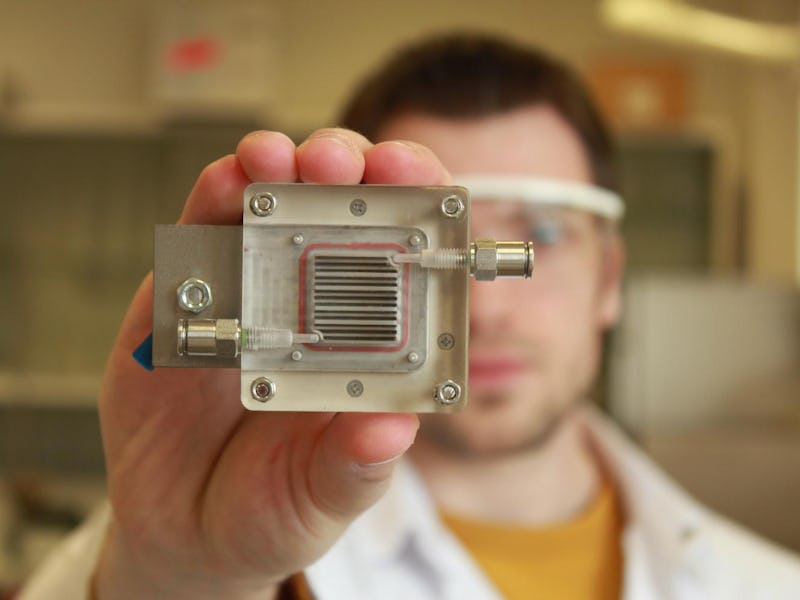This Amazing Chemistry Process Generates Power From Polluted Air
Two problems, one fix.

Scientists have found a way to address two environmental concerns at once: fossil fuel reliance and air pollution. Nope, it’s not too good to be true.
Researchers at the Belgian universities of Antwerp and Leuven created a device with two chambers: one cleans air by breaking down pollution materials, and the other creates hydrogen gas from those degraded materials. Hydrogen gas is a zero-emission fuel source.
The research, published in the journal ChemSusChem, relies on a set of nanomaterials called “photocatalysts” that are often used to extract hydrogen from water by breaking water molecules into their constituent parts (i.e. hydrogen and oxygen atoms). The researchers discovered that the photocatalysts could break down air pollution in the same way, and that it was an even more efficient process.
The device created by the University of Antwerp and KU Leuven team.
Air pollution is made of small organic molecules, and these molecules are less harmful when they’re broken down into even smaller pieces.
“Organic molecules are mostly built up out of carbon atoms, hydrogen atoms, and oxygen atoms,” Professor Sammy Verbruggen, a researcher from the team, explained to Inverse. Breaking down air pollution creates hydrogen atoms as a byproduct, and the second side of the device transforms these atoms into hydrogen gas (H2).
The photocatalysts operate in a membrane between the two chambers of the device. They only require light exposure to work, which means that this research could help create energy technology that’s reminiscent of solar panels. A solar panel generates energy immediately, though, whereas this process creates hydrogen gas that can only generate power separately.
If this process ultimately becomes a viable method of large-scale energy production, it will likely need to involve storing and transporting large amounts of hydrogen gas. Inverse asked Professor Verbruggen how this could be done with an industrially applicable quantity of gas.
“It is an entire field-of-study,” he says, “in the framework of the emerging hydrogen-economy. One of the available methods is to compress the gas at high pressure to store it in tanks and transport it as a liquid.”
But that concern is distant. The technology first needs to be significantly scaled up, because researchers are currently working with a scope of only a few square centimeters.
“After this first proof-of-concept it will still take at least a couple of years” until the technology becomes industrially applicable, Professor Verbruggen tells Inverse.
Abstract: The concept of an all-gas-phase photoelectrochemical (PEC) cell producing hydrogen gas from volatile organic contaminated gas and light is presented. Without applying any external bias, organic contaminants are degraded and hydrogen gas is produced in separate electrode compartments. The system works most efficiently with organic pollutants in inert carrier gas. In the presence of oxygen, the cell performs less efficiently but still significant photocurrents are generated, showing the cell can be run on organic contaminated air. The purpose of this study is to demonstrate new application opportunities of PEC technology and to encourage further advancement toward PEC remediation of air pollution with the attractive feature of simultaneous energy recovery and pollution abatement.